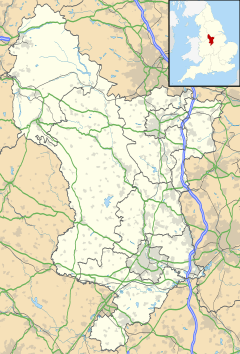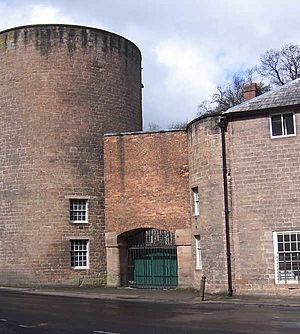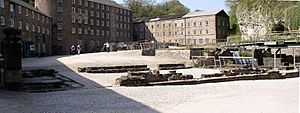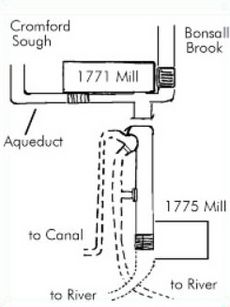Cromford Mill facts for kids
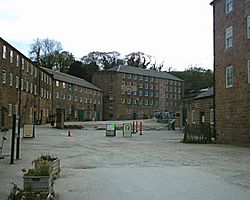
Cromford Mill
|
|
| Cotton | |
|---|---|
| Spinning Mill (Water frame) | |
| Structural system | Stone |
| Location | Cromford, Derbyshire |
| Owner | Arkwright |
| Coordinates | 53°06′32″N 1°33′22″W / 53.1090°N 1.5560°W |
| Construction | |
| Built | 1772 |
| Employees | 200 |
| Floor count | 5 |
|
Listed Building – Grade I
|
|
| Official name: Cromford Mill | |
| Designated: | 22 June 1950 |
| Reference #: | 1248010 |
Cromford Mill is a very important place in history. It was the world's first factory to spin cotton using the power of water! Richard Arkwright built it in 1771 in Cromford, England. This amazing building is now a Grade I listed building, which means it's super important and protected.
Today, Cromford Mill is a big part of the Derwent Valley Mills World Heritage Site. This means it's recognized by UNESCO as a special place for everyone to learn from and enjoy. It's now a busy visitor centre with shops, galleries, restaurants, and cafes.
Contents
Discovering Cromford Mill
Imagine a time when people made clothes by hand. In 1733, a new invention called the flying shuttle made weaving cotton much faster. This meant there was a huge demand for spun cotton thread. Machines for preparing and spinning cotton existed, but they weren't very good.
How the Mill Started
Richard Arkwright changed everything. In 1769, he invented the water frame. This machine used the power of a water mill to spin cotton much more efficiently. He had already tried a horse-powered mill, but water was much stronger!
Arkwright chose Cromford because it had a steady supply of warm water all year. This water came from the Cromford Sough, which was a channel draining water from nearby Wirksworth lead mines, and also from Bonsall Brook. In 1772, he built a five-storey mill here. With help from partners like Jedediah Strutt, he ran the mills day and night, with workers doing two twelve-hour shifts.
Life for Mill Workers
Arkwright started with 200 workers. This was more people than lived in the area! So, he built houses for them nearby. This was one of the first times a factory owner built homes for his workers.
Most of the people working at the mill were women and children. Some children were as young as seven years old. Later, the minimum age was raised to ten. These children also got six hours of education each week. This helped them learn to read and write, which their parents often couldn't do.
A large part of Cromford village was built just for the mill workers. These homes are now seen as the first factory housing development in the world! Workers had shops, pubs, chapels, and a school provided for them.
The mill gate was very strict. It closed exactly at 6 am and 6 pm every day. If a worker didn't get through the gate in time, they lost a day's pay. They were even fined another day's pay!
Special Money: Cromford Dollars

Around 1801 and 1802, there was a shortage of silver coins in England. To help, Spanish real coins were stamped with new marks. These special coins were then used as money at Cromford Mill. They were sometimes called "Cromford dollars."
Saving a Piece of History
The cotton mill stopped working in the 1800s. After that, the buildings were used for other things, like a dyeing plant. In 1979, a group called the Arkwright Society bought the site. They started the huge job of bringing it back to its original look.
Cromford Mill is important not just because it was the first, but because it was the first successful cotton spinning factory. It showed everyone how to build and run these new factories. Many other mills copied its design and methods.
A World Heritage Site
The Cromford Mill site is owned and being restored by the Arkwright Society. Historic England has called it "one of the country’s 100 irreplaceable sites." In 2018, the "Cromford Mills Creative Cluster and World Heritage Site Gateway Project" was a finalist for a special award. This award was for the "Best Major Regeneration of a Historic Building or Place."
By 2019, the Arkwright Society employed 100 people. They had spent about £48 million on restoring the mill.
Today, the mill and its buildings are open to visitors every day. People come from all over the world to see it. There's a visitors' centre, shops, and a café.
The nearby Cromford Canal towpath is also special. It's a Site of Special Scientific Interest (SSSI) because of its wildlife. In 2024, the mill was even used as a location for the BBC One TV show Antiques Roadshow.
Bringing the Mill Back to Life
In 1995, the 1771 mill building was much smaller. It had lost two of its five floors back in 1929. The site also had toxic waste from a paint-making factory that used to be there. This made it hard to access some areas. Only one mill building was safe for tours.
The Arkwright Society has worked hard to clean up the site and restore the buildings. In 2022, they got approval to install a new water wheel. They also added a modern 20 kilowatt hydro-turbine. This new turbine helps power the buildings using clean water energy.
Buildings and Water Power
Cromford Mill has several important buildings and structures.
The First Mills
The first mill was built in 1771. It was originally five storeys tall.
A second mill was built in 1775. Sadly, this mill was destroyed by fire in 1890.
How Water Powered the Mill
The mill used water from two sources: the Cromford Sough and Bonsall Brook. The sough was a channel that brought warm water from lead mines. Both of these water sources helped power the first mill.
Later, the sough water was separated from the brook. It was brought along a special channel and crossed a bridge called an aqueduct. This water then powered a new type of waterwheel. A complex system of channels and gates controlled the water flow. This ensured the mill had enough power. On Sundays, extra water could even be sent to the canal.
Arkwright's use of water caused some disagreements with other local people. They also needed water for their own uses. Over time, new drainage channels for the mines affected the water supply to Cromford Mill. After many legal discussions, the mill eventually lost some of its water rights. This meant that after 1847, Cromford Mills had to stop making cotton. The buildings were then used for other purposes.
Homes and Transport
The mill manager lived in a house right on the site. As the mill grew, more houses were built in Cromford village for the workers.
The Cromford Canal opened in 1793. This canal and its Cromford Wharf connected Arkwright's Mill to big cities in the Midlands and the north. This made it easier to transport cotton and goods. However, trains later became more popular, and the canal was used less.
Amazing Machines
The Water Frame Invention
At first, cotton was prepared by hand. But in 1775, Arkwright got another patent for a water-powered machine that prepared cotton. This machine, along with the water frame, greatly increased how much cotton the mill could produce.
Cromford Mill became very famous. Arkwright soon built more mills there and in other places. He eventually employed 1,000 workers at Cromford. Many other mills were built using his ideas, even in other countries like Scotland and Germany.
An apprentice of Arkwright's, Samuel Slater, took the secrets of these machines to America. He started the cotton industry in Pawtucket, Rhode Island. Arkwright's success led to challenges in court over his patents. One of his patents was even cancelled because it was decided his ideas weren't completely new. Still, by the time he passed away in 1792, he was one of the richest people in Britain who didn't have a noble title.
Today, Cromford Mill has a working copy of the original water frame. It was put in place in April 2013. It was tricky to find the right kind of cotton thread to make it work. No companies in the United Kingdom spin cotton like that anymore! Eventually, a company in Switzerland helped by providing some special cotton.
See also
 In Spanish: Cromford Mill para niños
In Spanish: Cromford Mill para niños
- Grade I listed buildings in Derbyshire
- Listed buildings in Cromford
- Kirk Mill
- Masson Mill
- New Lanark
Images for kids


